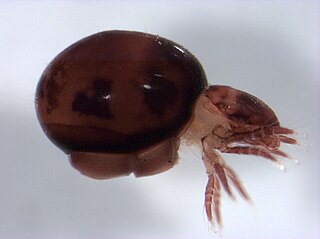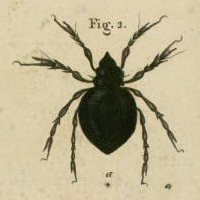Related Research Articles

Oribatida, also known as oribatid mites, moss mites or beetle mites, are an order of mites, in the "chewing Acariformes" clade Sarcoptiformes. They range in size from 0.2 to 1.4 millimetres. There are currently 12,000 species that have been identified, but researchers estimate that there may be anywhere from 60,000 to 120,000 total species. Oribatid mites are by far the most prevalent of all arthropods in forest soils, and are essential for breaking down organic detritus and distributing fungi.
Oribotritiidae is a family of mites in the order Oribatida.
Oribotritia is a genus of mites in the family Oribotritiidae.
Rhysotritia is a genus of mites in the family Euphthiracaridae.
Microtritia is a genus of mites in the family Euphthiracaridae.
Steganacaridae is a family of mites in the order Oribatida.
Notophthiracarus is a genus of mites in the family Steganacaridae.
Microtritia stria is a species of mite.

Blattisociidae is a family of mites in the order Mesostigmata.
Galumna pseudokhoii is a species of mite first found in Cát Tiên National Park, Vietnam, in dark loam in a Lagerstroemia forest. This species is very similar in the location and morphology of notogastral areae porosae, rostral morphology, lamellar and interlamellar setae, lamellar lines locations, and incomplete dorsosejugal suture to Galumna khoii, differing in body size, sensilli morphology, and the number of genital setae on the anterior parts of its genital plates.
Pergalumna indistincta is a species of mite first found in Cát Tiên National Park, Vietnam, in dark loam in a Lagerstroemia forest. This species is similar in notogastral areae porosae, punctate body surfaces, prodorsal setae morphology, and dorsosejugal suture, to Pergalumna amorpha, differing in body size and the development of its adanal setae.

Belba is a genus of mites belonging to family Damaeidae. The genus was established by Carl von Heyden in 1826. Notaspis corynopus was the type species. Species that are part of the genus can be found in Eurasia and North America.

Damaeidae Berlese (1896) is a family of mites. Alternative names for the family include Belbidae Willmann (1931), and Belbodamaeidae Bulanova-Zachvatkina (1967) or Hungarobelbidae (1996). They had been previously considered to be distinct families.
Neophyllobius is a genus of mites.
Lohmanniidae is a family of oribatids in the order Oribatida. There are at least 20 genera and 180 described species in Lohmanniidae.
Phenopelopidae is a family of oribatid mites in the order Sarcoptiformes. As of 2018, there were 4 genera and 106 species known in this family.

Oripodoidea is a superfamily of oribatids in the order Oribatida. There are about 19 families and at least 1,300 described species in Oripodoidea.

Galumna is a genus of mites in the family Galumnidae.

The UPLB Museum of Natural History is a natural science and natural history museum within the University of the Philippines Los Baños (UPLB) campus. It serves as a center for documentation, research, and information of flora and fauna of the Philippines. The museum is one of the research and extension units of the UPLB and its role parallels that of a library for written records.
Cochlodispus minimus is a species of mite from the family Microdispidae, formally described by Sándor Mahunka in 1976. One adult individual was measured with a body length of 79 μm, making it the smallest known mite species. It was originally described from Ethiopia, along with cogeners C. africanus and C. fimbrisetus, and inhabits soil and litter.
References
- ↑ Wojciech Niedbała (1993). "New species of Euptycima (Acari, Oribatida) from New Zealand". New Zealand Journal of Zoology . 20 (3): 137–159. doi: 10.1080/03014223.1993.10422856 .
- ↑ Niedbała, Wojciech; Starý, Josef (2014). "New and little known species of ptyctimous mites (Acari, Oribatida) from Costa Rica". International Journal of Acarology . 40 (4): 320–327. doi:10.1080/01647954.2014.920419.
- 1 2 3 Liu, D.; Zhang, Z.Q. (2015). "New Zealand Austrophthiracarus (Acari: Oribatida: Phthiracaridae): three new species from North Island and offshore islands". Systematic & Applied Acarology . 20 (3): 263–272. doi:10.11158/saa.20.3.4.
- ↑ Niedbala, W.; Stary, J. (2014). "New and little known species of ptyctimous mites (Acari, Oribatida) from Cameroon". Zootaxa . 3889 (1): 31–57. doi:10.11646/zootaxa.3889.1.2.
- 1 2 Liu, D.; Zhang, Z.Q. (2013). "Two new species of Austrophthiracarus (Acari: Oribatida: Phthiracaridae) from New Zealand". Zootaxa . 3682 (2): 385–391. doi: 10.11646/zootaxa.3682.2.10 .
- ↑ Liu, D.; Zhang, Z.Q. (2016) [Published online 2015]. "Review of the genus Austrophthiracarus (Acari, Oribatida, Phthiracaridae) with a description of a new species from Australia, a key to known species of the Australian Region and a world checklist". International Journal of Acarology . 42 (1): 41–55. doi:10.1080/01647954.2015.1109709.
- 1 2 Liu, D.; Chen, J. (2014). "Descriptions of Two New Species of Austrophthiracarus Balogh et Mahunka, a Newly Recorded Genus of Ptyctimous Mites from China (Acari: Oribatida: Phthiracaridae)". Annales Zoologici . 64 (2): 267–272. doi:10.3161/000345414X680618.
- ↑ Liu, D.; Zhang, Z.Q. (2014) [Published online 2013]. "Two new peculiar ptyctimous mites (Acari: Oribatida: Phthiracaridae) from the Australian region, with a key to 54 described species of Notophthiracarus Ramsay in Australia". Austral Entomology. 53 (2): 159–166. doi:10.1111/aen.12066.
- 1 2 3 Liu, D.; Zhang, Z.Q. (2014). "Three new species of the genus Austrophthiracarus from New Zealand (Acari: Oribatida: Phthiracaridae)". Zootaxa . 3780 (3): 585–593. doi: 10.11646/zootaxa.3780.3.10 .
- ↑ Niedbala, W. (2008). "Two new species of ptyctimous mites (Acari: Oribatida) from Ghana". African Zoology . 43 (2): 131–134. doi:10.1080/15627020.2008.11657229.
- ↑ Niedbala, W. (2017) [Published online 2016]. "New ptyctimous mites (Oribatida: Phthiracaroidea) from Australia". International Journal of Acarology . 43 (1): 73–85. doi:10.1080/01647954.2016.1220423.
- 1 2 3 Liu, D.; Wu, D. (2016). "Two new species of Austrophthiracarus (Acari: Oribatida: Phthiracaridae) from Capleston Biological Reserve in New Zealand". International Journal of Acarology . 42 (8): 416–419. doi:10.1080/01647954.2016.1212923.
- ↑ Niedbala, W.; Ermilov, Sergey G. (2016). "Checklist of ptyctimous mites (Acari, Oribatida) of New Zealand with descriptions of three new species". Acarologia . 56 (2): 203–211. doi: 10.1051/acarologia/20162239 .
- ↑ Niedbala, W.; Stary, J. (2011). "Three new species of ptyctimous mites (Acari: Oribatida: Phthiracaroidea) from Spain". Zootaxa . 2966: 58–64. doi:10.11646/zootaxa.2966.1.6.
- ↑ Liu, D.; Wu, D. (2017). "New species of the family Steganacaridae (Acari, Oribatida, Phthiracaroidea) from Northeast China with keys to known species of Austrophthiracarus and Hoplophthiracarus from the Palaearctic Region". Systematic & Applied Acarology . 22 (7): 915–924. doi:10.11158/saa.22.7.2.